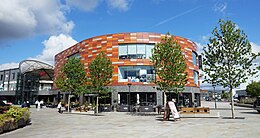Newport city centre



Newport city centre is traditionally regarded as the area of
Description
The main shopping thoroughfare is Commercial Street, which forms part of the north–south axis of High Street, Commercial Street and Commercial Road, linking the heart of the city with Newport Docks. The streets were laid-out in 1807 by Sir Charles Morgan's Tredegar Wharf Company to connect the expanding docks with the main roads in the centre.
The area between Commercial Street and the river used to contain a mixture of railway lines and river wharves so the street pattern in this area was never fixed. On the removal of the railway lines and wharves in the 1960s the large John Frost Square (1977) and Kingsway Shopping Centre were built, close to Newport bus station. This area has been redeveloped to provide the Friars Walk shopping and leisure complex which was opened in November 2015. As part of this redevelopment, the Chartist Mural was destroyed.
Towards the northern end of Newport city centre is Westgate Square, named after the Westgate Hotel. Here, the five roads of Commercial Street, Stow Hill, Bridge Street, High Street and Skinner Street converge. This is generally regarded as the centre although the actual centre, as measured on road signs, is further up Bridge Street outside the Queen's Hotel where most OS maps pin point the centre.
On Upper Dock Street is the Chartist Tower, a 15-storey office block, built in 1966 and the tallest building in Newport. It features a secure underground car park. Radio transmitters and mobile phone masts are situated on the roof. During the 2014 NATO summit a security forces command and control team was housed temporarily in the building, with the top floor and roof being used as an observation post.[1] In 2017 the building was sold as party of a £6.5M deal and has now been developed into a 163-bed Mercure hotel.[2][3]
From Bridge Street, the two roads of High Street and Cambrian Road run in parallel towards Newport railway station. Joining the two roads is the covered Victorian Newport Arcade. At the western end of the arcade is the Cambrian Centre which is being redeveloped.[4] To the east of High Street is Newport Market, a Grade II-listed building.
Kingsway/Usk Way is a boulevard on the west bank of the River Usk linking Newport Castle the
The city's major sports stadium, at Rodney Parade on the east bank of the River Usk, is a short walk from the city centre via Newport Bridge or Newport City footbridge.
Business

Many of the non-retail city centre businesses are located on Bridge Street. In 2014
Chartist Tower
The 16 storey Chartist Tower is the tallest building in Newport, and is currently undergoing a £10m redevelopment into a mixed use building by developers, set to include a hotel, 30,000 sq. ft of office space and 18,000 sq. ft of ground floor retail space.[6]
Shopping

Newport's city centre shops are concentrated along the


